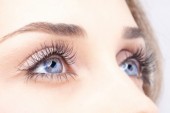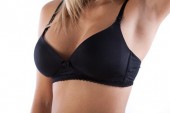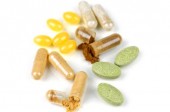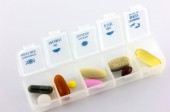Lutein is known for it's benefits to your eye health, but what about your cognitive health?
Additional Info
- Segment Number 1
- Audio File healthy_talk/1507ht4a.mp3
- Organization Life Extension
- Guest Website Healthy Talk MD
- Length (mins) 10
- Waiver Received No
- Internal Notes NO GUEST
- Host Mike Smith, MD
Listen in as Dr. Mike provides the answers to a wealth of health and wellness questions.
Additional Info
- Segment Number 5
- Audio File healthy_talk/1507ht2e.mp3
- Organization Life Extension
- Guest Website Healthy Talk MD
-
Transcription
RadioMD Presents: Healthy Talk | Original Air Date: February 10, 2015
Host: Michael Smith, MD
You’re listening to RadioMD. It’s time to “Ask Dr. Mike” on Healthy Talk. Call or email to ask your questions now. Email: AskDrMikeSmith@RadioMD.com or call: 877-711-5211. The lines are open.
Alright. Moving on with the questions here. This next one, I also had to have some help from the health advisory staff here at Life Extension because I’ve heard of this and I think I followed this question—this risk factor for breast cancer--for a little bit, but I really didn’t know where we were with any recent research. So, the question is, “I have two questions about breast cancer. First, does wearing a bra cause breast cancer? And second, do anti-perspirants that contain aluminum cause breast cancer?”
So, let’s take each one of these one at a time. So, the first one is about wearing a bra. Can it cause breast cancer? So, the theory originally—and I think this started maybe 20 years or so ago—there were some proponents that it was a risk; that wearing a bra was a risk factor. They were concerned, simplifying it, that it constricted the lymphatic flow in the breast tissue. So, you have different types of fluids that flow around your body, right? You, obviously, have the vessels. You have arteries and veins for blood, but there’s also another type of vessel called a “lymphatic” vessel. What the lymph systems does is it drains lymph nodes, right? So, a lymph node is a place where toxins and bacteria and viruses and even like cancer cells will collect. You have lymph nodes all over your body. They tend to concentrate in certain areas like in the breast, in the axillary region, which is basically the armpit, neck, groin, so you have these areas of tissue where bacteria, viruses, and toxins are brought because you have this concentration of immune cells in this lymph tissue—these lymph nodes. But see, here’s the thing. Once you bring viruses and toxins and bacteria to these areas and there is an immune response that happens there, you have to be able to drain it because if not, then the lymph tissue would just swell, swell, swell and it would basically burst and then dump all that gunk all over the place. That wouldn’t be good. So, you actually have a way to drain lymph nodes. It’s called “lymphatic” vessels or the “lymphatic system”. So, the thought was that if you are wearing something that constricts the lymphatic system, that that might not be great and could increase the risk for breast cancer. I guess, for guys, I guess I could extrapolate that to wearing tight underwear or jock straps. I mean, if you’re constricting the lymph tissues in the groin, could that increase my risk of testicular cancer? I mean, it’s all kind of the same thing, right? So, you’re not allowing the body to get rid of the gunk that’s building up in the lymph nodes. That’s basically what the theory was. And, that’s about as far as I knew. I wasn’t up to date on if there was anybody looking at this study. So far, research shows—and this comes from the help I had here at Life Extension—so far research shows the risk for breast cancer is the same regardless of a woman’s choice to wear a bra. A recent study published in October 2014, and I’m sorry I don’t have that journal cite, but a recent study published in October 2014, found no correlation between wearing a bra or not wearing a bra in breast cancer risk. If you are still concerned, try wearing a well-fitted bra without underwire and that should alleviate any pressure on the lymph system. As far as I know, there have never been any studies in, let’s say, jock straps in guys in the groin area and testicular cancer so, at this point, it does not seem that constricting lymph flow with outer garments increases the risk of cancer which makes sense.
I mean, you know, when you think of the anatomy, you can feel lymph nodes, especially when they get swollen. I mean, if you get a cold, just feel around your neck. You’ll feel some nodes. You know, in kids, they always have nodes anyway around their necks and stuff and you can sometimes feel them under your armpits and stuff. But, the actual drainage system—the lymphatic vessels are pretty deep. I’m picturing when I was in anatomy class that we had a couple of cadavers that we stripped completely bare except for the bones. We had another one that was stripped completely bare except for the arteries and one that was only showing the veins. I remember we had one that was only the lymphatic system and I remember looking at that and when you look at those cadavers, if you could almost put them together in your mind, you could see that the lymph system was pretty deep. So, it would take some pretty tight clothing or bras or jock straps to really cause a compression of the lymph tissue. So, that makes sense to me.
Now, let’s go on to the next question which was about the aluminum. Now, listen, aluminum’s a metal. Metals cause oxidative stress and oxidative stress is one of the leading theories of aging and the development of all kinds of chronic, age-related diseases. So, right there you know that putting metals on your body, in your body, is not always the greatest thing, definitely on a daily basis. I mean, you do need some of these metals to live, but the question is, how much. I mean, can you overdo it and I think that’s where the concern is with anti-perspirants. There’s a lot of aluminum. The skin under the arms is quite thin. It does absorb there pretty readily. That’s why it works. That’s why it stops sweating and so you probably are getting a decent load of aluminum from an anti-perspirant. But, the question is, is that dangerous? I mean, is it enough to cause problems, like say, with dementias which we already have connected to aluminum.
But, in this case, when it comes to breast cancer, here’s what we’ve found. As far as anti-perspirants go, this concerned an issue that came about when aluminum was found in breast tumors. Aluminum is a common ingredient in anti-perspirants and prevents sweat from reaching the body’s surface. Proponents argue that sweat eliminates toxins which could otherwise be carcinogenic. While we see the logic in this, foregoing anti-perspirants isn’t really necessary. Most of the toxins eliminated by the human body are excreted via the digestive system and urinary systems. If you still remain concerned, opt to wear deodorants with natural ingredients. Deodorants do not prevent the release of sweat. It’s the anti-perspirant part. So, again, when it comes to bras and anti-perspirants, there’s no real evidence in the literature that we have to worry about that.
I saw a caller come on, but it looks like they were taken off the board which is probably good because I don’t think I have too much time left.
Let me go to a quick question here. “My hot flashes aren’t really that bad but, nevertheless, I’d like not to have them. I’ve read some promising information on hops. What do you think? Are hops really that good at stopping hot flashes?”
Yes. You know, it’s not traditional. Dong quai, black cohosh, estrogen replacement therapy-- those are the traditional things that women will do to prevent menopausal symptoms. I think this should actually be a good segment. I should do one on menopause and some of the latest stuff because hops, along with another type of nutrient called “lignans” from the bark of trees like Norway spruce, for instance, have been shown to reduce hot flash symptoms in some cases better than the traditional stuff, other than estrogen. Estrogen’s the best way to go. I mean, if you’re having menopausal symptoms like hot flashes and your estrogen’s low, progesterone’s out, replacing those hormones with bio-identical formulations is the best way to handle that. But, if you don’t want to do that, which is fine—that’s your choice--hops and lignans—I don’t remember the data specifically, but we’re talking about reducing the number of hot flashes significantly by a third, maybe up to a half, which really is better than some of the traditional stuff that women use like black cohosh which really is pretty inconsistent in the literature. So, hops. Yes. I think hops would be a good one to try and, if not, maybe even add some lignans to it. Norway spruce lignans.
This is Healthy Talk on RadioMD. I’m Dr. Mike. Stay well. - Length (mins) 10
- Waiver Received No
- Internal Notes NO GUEST
- Host Mike Smith, MD
Listen in as Dr. Mike provides the answers to a wealth of health and wellness questions.
Additional Info
- Segment Number 4
- Audio File healthy_talk/1507ht2d.mp3
- Organization Life Extension
- Guest Website Healthy Talk MD
-
Transcription
RadioMD Presents: Healthy Talk | Original Air Date: February 10, 2015
Host: Michael Smith, MD
It’s time for you to be a part of the show. Email or call with questions for Dr. Mike now. Email: AskDrMikeSmith@RadioMD.com or call: 877-711-5211. What are you waiting for? The doctor is in.
That’s 877-711-5211. Give me a call if you want to say “hi” and ask a question. You can also send me your emails, AskDrMikeSmith@RadioMD.com.
This first question, I have to admit, I forgot to print it out, but I remembered it because it was based on a previous segment I did, maybe last week. I don’t remember exactly, but it was on sugary sodas—carbonated, sugary sodas—and the harm they do to your body. Specifically, they reduce the length of the telomere which is your biological clock. The shorter and shorter the telomere gets, the older and older the cell is. It’s one of the theories of aging. So, this person asked the question about sports drinks and I don’t remember the whole question, but basically, you know, the gist of it was, he stopped drinking the carbonated, sugary sodas, switched over to kind of fruit juices—sports drinks, I think he said—and he wondered if that was okay. Well, from the perspective of the telomere shortening, they did test different types of sugary drinks. They looked at carbonated, non-carbonated. I don’t know if they specifically looked at fruit juice versus a sport drink, but I do remember that being a division in the study—carbonated versus uncarbonated—and the only type of drink that shortened the telomeres was the sugary, carbonated drinks. So, at least for now—remember, in science, we’re always learning things, right? It’s dynamic. It’s always changing. At least for now, based on one study, sport drinks and fruit juices should be okay when it comes to telomere length. Just definitely don’t do the, you know, the Cokes and all that kind of stuff. Okay. So, that’s just with telomeres, though. So, that’s the good news, I guess. But, I have to talk a little bit about the bad news. There are other studies, though. Forget telomeres for now. There are other studies that have clearly shown that one 12-ounce sugary drink a day, regardless of the source—even the fruit juices--you have to be careful. If there’s a lot of sugar in that 12-ounce drink, which is the standard. Eight to twelve is kind of the standard they used in the study. So, 8 to 12 ounces of sugary drinks—carbonated or not—significantly increases the risk of diabetes and diabetes is devastating. So, one on hand, you know, based on how the question was asked, okay, in terms of telomere length, sport drinks that are loaded with sugar, fruit juices, should be fine. But, in terms of diabetic risk, diabetes risk? No. It’s not fine. We should be drinking more water. Water. And we have to get over that. We have to get over this need to be drinking anything but water. Now, I’m not saying you should be boring with everything. You know, a glass of wine on occasion. A beer here and there. Some coffee in the morning. Fine. But, we are addicted to sugar. So, this person who wrote this question went from the sugary carbonated drinks to sugary noncarbonated drinks. Well, to me, that’s not much of an improvement. It’s still sugar. So, we need to get off those types of drinks completely. We need to get more into water, water and more water. Okay. So, that was the first question.
Question number two. Oh, and I had to write this down. Okay. I actually answered this question during the break here. The question is: “You once did a show on the 17 heart disease risk factors. Can you review them again?” Okay. So, I actually go over the questions in preparing for the show ahead of time and I saw this and I said, “Oh, God. That’s easy. I can answer that. No problem.” And, in between the segments, I looked at the question again and I thought, “Wow. Can I come up with the 17 risk factors?” So, I did my best here and wrote them down and I got to about 14 of the 17 heart disease risk factors that I’ve talked about before. So, I had to go on LifeExtension.com. If you search 17 heart daggers, we have this nice image where the risk factors are represented as daggers stabbing the heart. You can see all 17. So, I had to go there to finish my list here. So real quickly, the 17 heart disease daggers or risk factors would be: High bad cholesterol (LDL), low HDL (the good stuff), high Triglycerides. Let’s see. Number four. High sugar or diabetes, right? Then, we have inflammation, low testosterone, high estrogen, high fibrinogen, high homocysteine, low Vitamin D, low Vitamin K2, low amounts of Omega-3 oils, low what’s called PON1. PON1. It’s an enzyme that prevents oxidization of fat. So, low PON1. High blood pressure, lots of belly fat, smoking and then, lastly, of course, if you already have a history. Either a family history—first degree relative--or your own person history of heart disease. Those are the 17 heart disease risk factors. So, I had to look that up myself. Go to LifeExtension.com for the awesome image with the daggers. Okay.
Question number 3. How am I doing on time? I think I’m okay. Alright.
Question number 3. Because these next two questions are kind of long. So, this next one I had to have some help in answering this. You know, I have a whole staff of health advisors at Life Extension that can help me at times. So, the question was: “Will adding butter to my morning coffee really cut food cravings later in the day?” So, there is a movement, I guess, in the health and nutrition world of adding butter and, I think, maybe coconut oil--what’s called a medium chain triglyceride oil like coconut oil--to coffee and I just went blank on the name of it. Bulletproof coffee. Have you heard of that before? Bulletproof coffee. So, you take your morning coffee, which I like black, so I can’t imagine adding organic butter. That’s what it says here. “Organic butter” and coconut oil to it. But, apparently it does taste pretty good from what I understand. I even had some health advisors try it and they said it was pretty awesome. So, let’s go to the question. “Will adding butter to my morning coffee,” basically creating this Bulletproof coffee, “Will it cut my food cravings later in the day?” And, the answer I got from the health advisors here at Life Extension was “maybe”. It will boost energy levels if you’re on a ketogenic diet where you have a lot of low carbs, higher fat. Large amounts of fat should effectively kill the appetite for many hours, especially for people who are ketoadapted and used to eating a low carb/high fat diet. This could also provide plenty of energy by elevating ketone levels in the blood which then become available as fuel for the brain. Again, it’s called “bulletproof coffee”. I’m reading this right from our awesome health advisors at Life Extension. Fat plus coconut oil plus coffee. Bulletproof coffee. It’s important to keep in mind that everything in nutrition depends on dosage and context. Just because a little bit of something is healthy, it doesn’t mean that a whole ton of it is healthy or healthier or even safe. One expert compared her egg breakfast with fruit to bulletproof coffee and concluded that if you’re used to eating three meals per day, then replacing breakfast with bulletproof coffee will reduce the total nutrient load of your diet by a third because you’re just basically gaining fat. Right? You’re getting a lot of fat which may cut appetite, but you’re missing out on nutrition. I think it’s irresponsible for me to support anything that cuts away from a balanced diet and supplement approach. I mean, that’s just the truth of it.
So, can you do this on occasion? Probably. I don’t know why you would want to do it on occasion. But, doing this every day, I just don’t know if it’s necessary and it would worry me that you’re going to get full. You’re going to get full on fat and you’re going to be missing the nutrition, especially at breakfast when most people drink coffee. And that’s when you need a good meal--a good balanced meal at breakfast. So, will it cut food cravings? Yes. Fat will do that, but it may not be the best way to do it.
Alright.
This is Healthy Talk on RadioMD. I’m Dr. Mike. Stay well. - Length (mins) 10
- Waiver Received No
- Internal Notes NO GUEST
- Host Mike Smith, MD
Is there a certain amount of omega-3s you should be aiming for?
Additional Info
- Segment Number 3
- Audio File healthy_talk/1507ht2c.mp3
- Featured Speaker Bill Harris, PhD
- Guest Website Omega Quant
-
Guest Bio
 Dr. Bill Harris is an internationally recognized expert on omega-3 fatty acids and how they can benefit patients with heart disease.
Dr. Bill Harris is an internationally recognized expert on omega-3 fatty acids and how they can benefit patients with heart disease.
He obtained his PhD in Human Nutrition from the University of Minnesota, and did post-doctoral fellowships in Clinical Nutrition and Lipid Metabolism with Dr. Bill Connor at the Oregon Health Sciences University. His interest in omega-3 fatty acids began with his postdoctoral work when he published his first study on the effects of salmon oil on serum lipids in humans (1980).
Since that time he has been the recipient of five NIH grants for studies on the effects of omega-3 fatty acids (EPA and DHA) on human health. He has over 190 publications relating to omega-3 fatty acids in medical literature and was an author on two American Heart Association scientific statements on fatty acids: "Fish Consumption, Fish Oil, Omega-3 Fatty Acids and Cardiovascular Disease" (2002), and "Omega-6 Fatty Acids and Risk for Cardiovascular Disease" (2009) both published in the journal Circulation.
Dr. Harris is a Senior Scientist at Health Diagnostic Laboratory; a Professor in the Department of Medicine, Sanford School of Medicine, University of South Dakota; and the President and CEO of OmegaQuant. - Length (mins) 10
- Waiver Received No
- Host Mike Smith, MD
Can incorporating omega-3 fatty acids into your diet reverse any damage done to your heart?
Additional Info
- Segment Number 2
- Audio File healthy_talk/1507ht2b.mp3
- Featured Speaker Bill Harris, PhD
- Guest Website Omega Quant
-
Guest Bio
 Dr. Bill Harris is an internationally recognized expert on omega-3 fatty acids and how they can benefit patients with heart disease.
Dr. Bill Harris is an internationally recognized expert on omega-3 fatty acids and how they can benefit patients with heart disease.
He obtained his PhD in Human Nutrition from the University of Minnesota, and did post-doctoral fellowships in Clinical Nutrition and Lipid Metabolism with Dr. Bill Connor at the Oregon Health Sciences University. His interest in omega-3 fatty acids began with his postdoctoral work when he published his first study on the effects of salmon oil on serum lipids in humans (1980).
Since that time he has been the recipient of five NIH grants for studies on the effects of omega-3 fatty acids (EPA and DHA) on human health. He has over 190 publications relating to omega-3 fatty acids in medical literature and was an author on two American Heart Association scientific statements on fatty acids: "Fish Consumption, Fish Oil, Omega-3 Fatty Acids and Cardiovascular Disease" (2002), and "Omega-6 Fatty Acids and Risk for Cardiovascular Disease" (2009) both published in the journal Circulation.
Dr. Harris is a Senior Scientist at Health Diagnostic Laboratory; a Professor in the Department of Medicine, Sanford School of Medicine, University of South Dakota; and the President and CEO of OmegaQuant. - Length (mins) 10
- Waiver Received No
- Host Mike Smith, MD
Your body can realistically handle up to 400-500 measurable toxins; but what damage is being done to your health?
Additional Info
- Segment Number 1
- Audio File healthy_talk/1507ht2a.mp3
- Organization Life Extension
- Guest Website Healthy Talk MD
- Waiver Received No
- Internal Notes NO GUEST
- Host Mike Smith, MD
Listen in as Dr. Mike provides the answers to a wealth of health and wellness questions.
Additional Info
- Segment Number 5
- Audio File healthy_talk/1507ht1e.mp3
- Organization Life Extension
- Guest Website Healthy Talk MD
-
Transcription
RadioMD Presents: Healthy Talk | Original Air Date: February 9, 2015
Host: Michael Smith, MD
It’s time to “Ask Dr. Mike”. Do you have a question about your health? Dr. Mike can answer your questions. Just email at: AskDrMikeSmith@RadioMD.com or call now: 877-711-5211. The lines are open.
So, the first question that I want to answer today is actually related to a segment that I had with Gretchen DuBeau who is the legal director for the Alliance of Natural Health, USA. So, this is about the New York Attorney General who pulled some herbal supplement products off the shelves in big stores like Target, Walgreens, and Walmart. I think there were one or two more, but, you know, big stores. Maybe even GNC was involved with this. They tested these products and then claimed that, you know, the labels were false—that they couldn’t find the specific herb that that product, at least that label, was claiming it had and there were even some other preservatives in these products that shouldn’t have been in there.
So, the question is: “I don’t understand the testing used by the New York Attorney General. Please explain.”
So, what they did is known as DNA bar code testing. I mean, just to really keep it simple, all they’re doing is, you take the product off, you take the capsule, you open it up and you take the powder that was in the capsule and you run it through some different methodologies that try to identify the DNA footprint of the herbs that are supposed to be in there. So, let’s say there’s a boswellia product. Boswellia is a wonderful anti-inflammatory. It comes from a medicinal tree. So, let’s say you take that product off. You open up the capsule and what you’re going to look for is boswellia DNA and, if it’s there, okay. Great. If it’s not there, okay. There’s an issue. The problem with this form of testing is, first of all, it’s not a standard form of testing for raw materials. Okay? It has lots of credibility issues, even within the industry itself and also within regulatory institutions. No one has really accepted DNA bar coding. It’s a quick way to get an idea of what’s in there, but it doesn’t look at levels. It doesn’t take into account how long something’s been on the shelf. There are a lot of contamination issues when you’re looking at DNA. So, DNA bar code testing just is not accepted. It’s a substandard form of testing the quality of a product. But, it’s quick. It can be done by most labs and so that’s why it’s sometimes used by the Federal regulating institutions and, in this case, the state of New York. So, it’s a methodology that’s not accepted. I mean, it is what it is. It’s not accepted.
So, what you have, then, is a report claiming that some of these products did not have the active constituents—the active herbal components in it—based on this substandard form of testing. But, mainstream media doesn’t care. They just want the headline. And, by the way, that’s exactly what the New York Attorney General did is, he released talking points. He didn’t release the actual results of the testing. This has not been published in any peer review journal or anything like that. They did their own testing using this DNA bar code substandard methodology and they released talking points—headlines—that ABC News and NBC News, even Fox, I mean, all of them, picked it up and started claiming that herbal supplements are useless. There’s nothing in them. That they’re mislabeled and so on from there. Yet, the actual report hasn’t even been released. They’re not releasing it. Of course, the supplement industry—the herbal industry—are asking for the actual results and, at this point, the New York Attorney General is holding onto them because he knows that it’s a substandard form of testing. So, it’s really becoming more of a political thing than it is about public safety or anything like that. So, there you go. It’s called DNA bar coding and it’s a quick, easy way to check for some things that might be in a product, but it’s not accepted because there are just so many issues with it--so many contamination issues with it—and so, it’s not used. No one uses it but people like the New York State Attorney General.
Okay. Let’s go on to the next question and this one is related to this. “So, what is the best way to know if a supplement is high quality?”
So, there are a few things to do here and I write about this in my book, The Supplement Pyramid: How to Build Your Personalized Nutritional Regimen. It’s available at LifeExtension.com and Amazon.com. I have a whole chapter on how to choose a quality product. It’s really pretty simple. The first thing—and this is what I do—the very first thing I do is I stick with companies that have been around a long time because I know they have good track records. There are a whole bunch. In my book, even though I work for Life Extension, I list about 12 other companies that I really like and use: Source Naturals, New Chapter, Enzymatic Therapy, just to name a few. I mean, there are some really good companies out there making great products. They’ve been around for many, many, many years and over and over again, their products have proven to be high quality. So, number one, stick with companies that have been around. There is an issue. There are some, what you might call “fly by night” companies. They jump on, I don’t know, the latest and greatest nutrient bandwagon. They make a few products, sell it online, whatever, and then a year later, they’re gone. I mean, well, don’t buy from them. That’s what I said. Stick to the companies that have been around for 10 plus, 15 plus years. That’s number one.
Number two, on the back label, there’s a manufacturing number. There should be. If there’s not, you probably don’t want to buy that product. But, there should be a number—a phone number you can call. That’s the manufacturer of that product. Call that number and whoever answers—you can do this right in the aisle with your cell phone. Call that number. Whoever answers, you ask them for a Certificate of Analysis or you ask them if they have one. “Does this product have a Certificate of Analysis?” C-O-A. And, if the person on the other phone says, “What? What are you talking about?” you probably want to hang up and find another product. All of those companies I have in the back of my book and the ones that have been around a long time and they have great track records, they all produce a C of A for their products, their raw materials, their final label. Basically, a C of A is an analysis of the ingredients and the label. In many cases, it’s a third party lab that’s testing this for them. Okay? So, right there. Most of these companies produce C of A’s. I know Life Extension does. Very simple. Other things I like to do? I mean, I like to buy products that have nice, clean labels. What I mean by that is, you know, easy to read, front and back, the inactive ingredients are clearly listed and separated from the active constituents--the active components of the products, the dosing is clearly labeled, the serving size. I mean, the easier the label is to look at and to read and know what you’re purchasing, in many cases, that’s a good, quality product, you know? So, stick with good companies—companies that have been around for 10 plus, 15 plus, years. Go ahead and call that manufacturing number as an extra step and say, “Hey, does this product have a C of A?” Now, if they say “yes”, that’s probably all you need. It just gives you confidence in what you’re buying. Now, if you want to go a step further, which some people do, ask them to email it to you, fax it to you. Whatever. Once you get it, you can confirm it and then you can buy the product, but I don’t think you have to go that far as long as you know they have it and they’re willing to share it with you, I think that’s enough. Then, of course, you know, easy to read labels clearly identifying active components from inactive components, dose, serving size, you know, just right there. Again, it’s just building confidence and credibility in the product that you’re purchasing. So, there you go.
This is Healthy Talk on RadioMD. I’m Dr. Mike. Stay well. - Length (mins) 10
- Waiver Received No
- Internal Notes NO GUEST
- Host Mike Smith, MD
What can you do to ensure you're buying and using a trusted product?
Additional Info
- Segment Number 4
- Audio File healthy_talk/1507ht1d.mp3
- Featured Speaker Gretchen DuBeau, Executive Director, Alliance for Natural Health USA
- Organization Alliance for Natural Health USA
-
Guest Bio
 Gretchen DuBeau joined the Alliance for Natural Health USA (formerly the American Association for Health Freedom) as Executive and Legal Director in 2008.
Gretchen DuBeau joined the Alliance for Natural Health USA (formerly the American Association for Health Freedom) as Executive and Legal Director in 2008.
A lifelong environmentalist and devotee to natural health and healing, Gretchen has found the perfect culmination of her interests at ANH-USA, where she works to shift the current medical paradigm to one that embraces real preventive and integrative medicine as the standard of care.
Gretchen also serves as President and Executive Director of the Praktikos Institute, and as Advocacy Coordinator for ANH-International. In 2014, she was appointed President of the Axios Institute.
She is an attorney and practiced environmental law and policy for five years before joining ANH to work on natural and sustainable health issues.
Gretchen holds a Masters Degree in Applied Healing Arts. She supports the Integrative Medicine Consortium (IMC) as the Public Affairs Chair and the Public Policy Co-chair, serves as Board Advisor to the International College for Integrative Medicine (ICIM), and joined the boards of the ANH-USA in 2010; the Certification Board for Nutrition Specialists (CBNS), where she serves as Treasurer, in 2011; ANH-International and the Institute for Responsible Technology in 2012; and the Praktikos Institute in 2014. - Length (mins) 10
- Waiver Received No
- Internal Notes NO GUEST
- Host Mike Smith, MD
How can you O-W-N your diabetes in three simple steps?
Additional Info
- Segment Number 3
- Audio File healthy_talk/1507ht1c.mp3
- Featured Speaker Natalie Strand, MD
- Book Title A Woman's Guide To Diabetes: A Path To Wellness
-
Guest Bio
 Natalie Strand, MD, is a physician who has been living with diabetes for over 23 years and co-author of A Woman's Guide To Diabetes: A Path To Wellness.
Natalie Strand, MD, is a physician who has been living with diabetes for over 23 years and co-author of A Woman's Guide To Diabetes: A Path To Wellness.
She gained national attention as part of the first female team to win the CBS reality series The Amazing Race. "Dr. Nat" continues to inspire millions of people as a motivational speaker and spokesperson, by connecting with the diabetes community across multiple media platforms and providing practical insights on dealing with the daily realities of diabetes.
She works extensively to promote an active lifestyle in people living with diabetes. - Length (mins) 10
- Waiver Received No
- Host Mike Smith, MD
What are some challenging issues that women who have been diagnosed with diabetes face at different stages in their lives?
Additional Info
- Segment Number 2
- Audio File healthy_talk/1507ht1b.mp3
- Featured Speaker Natalie Strand, MD
- Book Title A Woman's Guide To Diabetes: A Path To Wellness
-
Guest Bio
 Natalie Strand, MD, is a physician who has been living with diabetes for over 23 years and co-author of A Woman's Guide To Diabetes: A Path To Wellness.
Natalie Strand, MD, is a physician who has been living with diabetes for over 23 years and co-author of A Woman's Guide To Diabetes: A Path To Wellness.
She gained national attention as part of the first female team to win the CBS reality series The Amazing Race. "Dr. Nat" continues to inspire millions of people as a motivational speaker and spokesperson, by connecting with the diabetes community across multiple media platforms and providing practical insights on dealing with the daily realities of diabetes.
She works extensively to promote an active lifestyle in people living with diabetes. - Length (mins) 10
- Waiver Received No
- Host Mike Smith, MD









